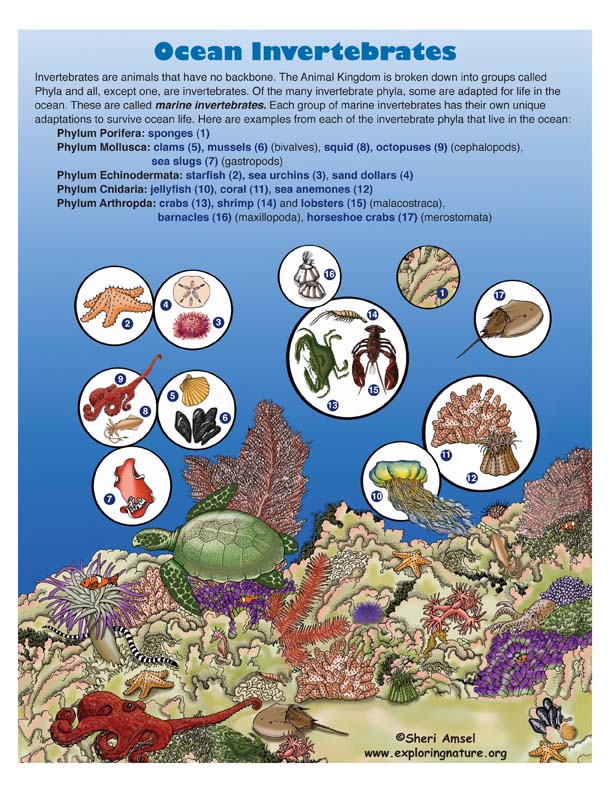

Invertebrates are animals that have no backbone. The Animal Kingdom is broken down into groups called Phyla and all, except one, are invertebrates. Of the many invertebrate phyla, some are adapted for life in the ocean. These are called marine invertebrates. Each group of marine invertebrates has their own unique adaptations to survive ocean life. One group is made up of sponges (1) (porifera). As adults, sponges attach themselves to the ocean floor where they live on small bits of food brought to them by wave action. Another group of marine invertebrates (mollusca) include oysters, clams (5) and mussels (6) (bivalves). They are called bivalves because they are protected by a two-sided, hinged shell kept closed by a strong muscle. Another group includes starfish (2), sea urchins (3) and sand dollars (4) (echinodermata). Starfish are slow but powerful predators. They work the shell of a mussel open and expel their stomachs out of their mouths and into the mussel where they digest them. Sea slugs (7) and snails are in another group (gastropods). Sea slugs are not like their terrestrial cousins. They come in many shapes with stunning colors and patterns. Squid (8) and octopuses (9) (cephalopods) use camouflage and jets of water to escape predators and have a sharp beak to stab prey. Jellyfish (10), coral (11) and sea anemones (12) (cnidaria) make up another group that uses poison stinging cells to stun their prey. Crabs (13), shrimp (14) and lobsters (15) (malacostraca) have a protective outer shell and powerful pinching claws. They are related to the barnacles (16) (maxillopoda) adapted for life in and out of the water as the tide rises and falls and horseshoe crabs (17) (merostomata) that have survived in their niche for many thousands of years.
When you research information you must cite the reference. Citing for websites is different from citing from books, magazines and periodicals. The style of citing shown here is from the MLA Style Citations (Modern Language Association).
When citing a WEBSITE the general format is as follows.
Author Last Name, First Name(s). "Title: Subtitle of Part of Web Page, if appropriate." Title: Subtitle: Section of Page if appropriate. Sponsoring/Publishing Agency, If Given. Additional significant descriptive information. Date of Electronic Publication or other Date, such as Last Updated. Day Month Year of access < URL >.
Amsel, Sheri. "Ocean Invertebrate Color Poster" Exploring Nature Educational Resource ©2005-2024. December 31, 2024
< http://www.exploringnature.org/db/view/629 >
